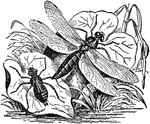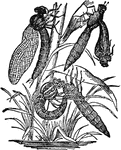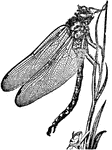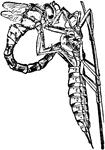Clipart tagged: ‘dragon fly’

Dragon Fly and Nymph
An illustration of a dragon fly (right) and a nymph (left). A dragonfly is a type of insect belonging…

Dragonfly
"The Dragon Fly has a large, broad head, very freely attached to the thorax, and large, convex, prominent…

Dragonfly
"The anterior portion of the body of Aeschua cyanea freed from the puparium." — Encyclopedia Britannica,…

Dragonfly
"The perfect insect (the wings having acquired their full dimensions) resting to dry itself, preparatory…

Dragonfly
A dragon-fly and its development. Larva and pupa feeding at 1 and 3; 2, nymph ready to change; 4, a…



